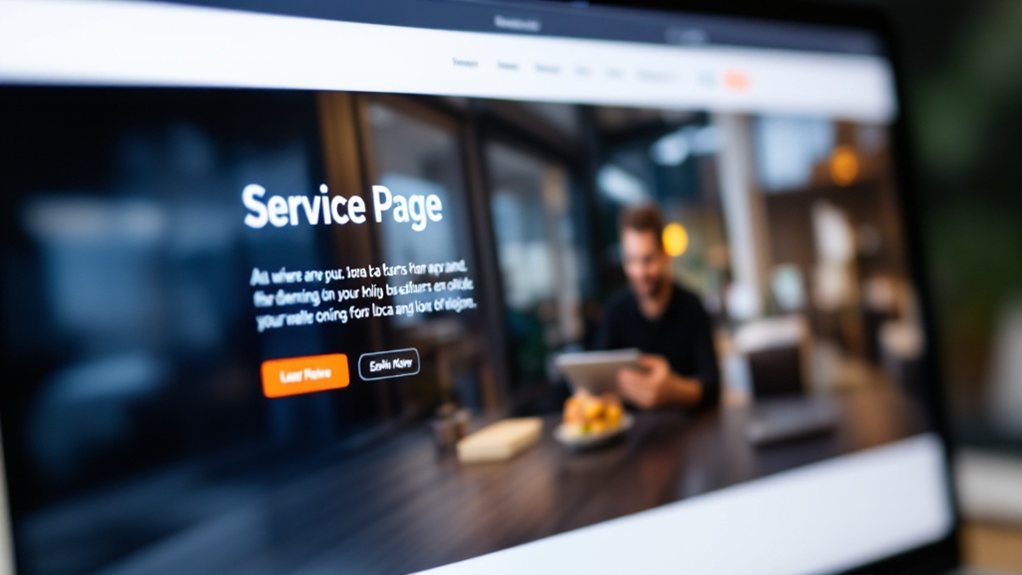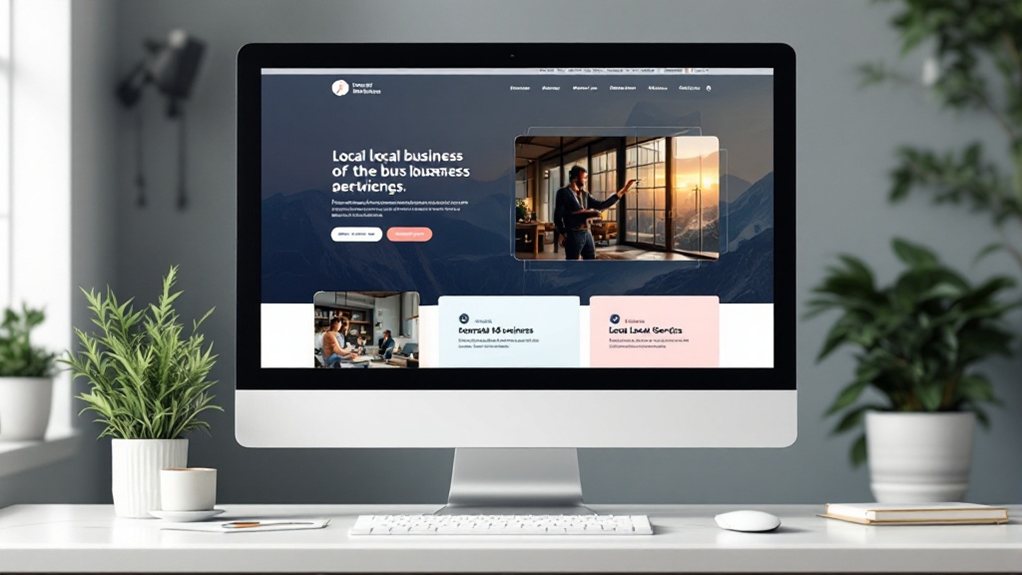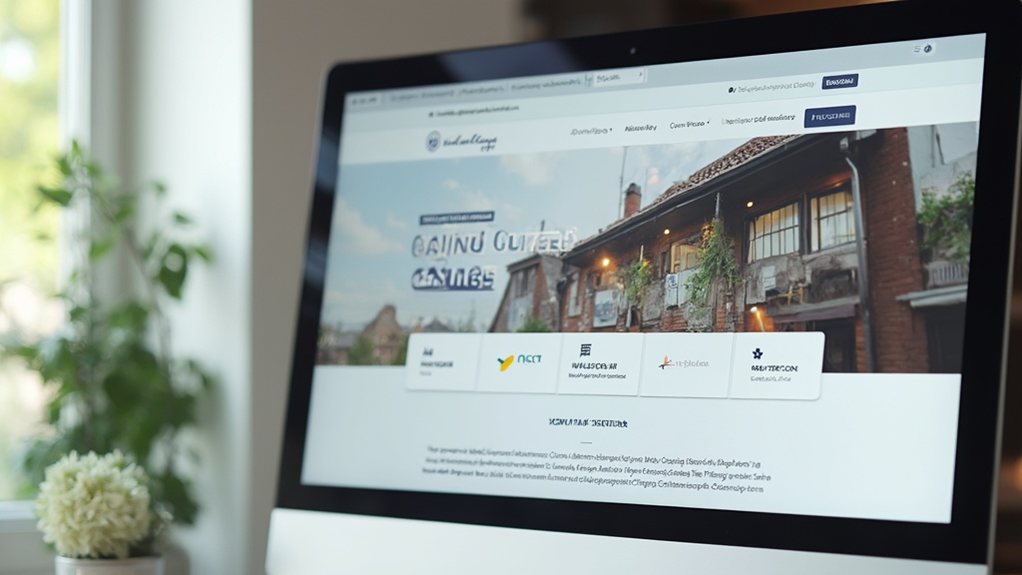To create engaging local business service pages, you'll need to prioritize your core offerings, use clear and compelling service descriptions, and organize your content for easy navigation. Strategically place call-to-actions, and design a user-friendly, visually appealing experience. Incorporate visuals and interactive elements to bring your services to life, build local community connections, and optimize for mobile and performance. By following these steps, you'll be well on your way to creating service pages that truly resonate with your target audience.
Prioritizing Core Services

As a business owner, prioritizing your core services is crucial for success. Identify the key offerings that are essential to your business's success, and focus on these. Assess local market demand to tailor your services to unique community needs. Conduct competitor analysis to identify gaps in the market that your core services can fill. Consider customer preferences and reviews to refine your offerings. Align your core services with your overall business goals to ensure strategic alignment. Set clear objectives, allocate resources effectively, and monitor market trends to adjust your service offerings accordingly. Use customer feedback to continuously improve your core services, and only expand when aligned with your established goals. Leveraging your unique selling proposition can help differentiate your core services in the local market.
Crafting Clear Service Descriptions

Service descriptions should be straightforward and concise. Emphasize the key benefits customers will gain from each service offering. A well-written service description provides details about the service and its benefits. Using clear language and highlighting service advantages will make it easier for your audience to understand what you provide. Knowing how to write a service description can help services stand out.
Straightforward Language Use
When crafting clear service descriptions, straightforward language is paramount. Avoid industry jargon and opt for simple, everyday terms your audience will understand. Use short, concise sentences to enhance readability, and minimize filler words that add no substance. Tailor your tone to align with the service you provide and resonate with your target customers. Consider their level of understanding and adjust your language accordingly. Service pages aim to perform well in search results and convert consumers who visit the pages.
| Concise Sentences | Everyday Language | Resonant Tone |
|---|---|---|
| Enhance clarity | Ditch technical jargon | Match service |
| Improve readability | Use simple terms | Appeal to audience |
| Reduce complexity | Explain details clearly | Convey value |
Emphasize Service Benefits
Shifting the focus to the benefits your services provide is key. Service descriptions should explain how your offerings solve your clients' problems. Highlight the advantages they'll enjoy, such as:
- Improved outcomes or measurable results that demonstrate your expertise
- Cost savings or enhanced convenience for their business
- Ways your services meet their specific needs, boosting your brand's relevance
Accurate and complete GBP descriptions are essential for gaining new customers.
Emphasizing these benefits, rather than just listing features, will increase customer confidence and engagement. By demonstrating how your services deliver real value, you'll attract the right clients seeking your unique solutions.
Organizing Services for Easy Navigation

Organizing your services for easy navigation is crucial in today's digital landscape. Use straightforward headings and subheadings to simplify navigation, and implement a responsive design to ensure usability on various devices. Include a search function to help visitors find specific services, and use breadcrumbs to provide a clear path through your website. Organizing content logically enhances user experience and SEO. Limit the number of navigation menu items, and use concise and descriptive labels. Ensure drop-down menus are structured and easy to navigate, and remove nonessential items to streamline the navigation bar. Prioritize user-centered design and mobile-friendly layouts to foster trust, engagement, and conversions.
Strategically Placed Call-to-Actions
Why are strategically placed call-to-actions (CTAs) so crucial for your local business service pages? CTAs guide users towards desired actions, boosting conversions by up to 66%. Effective CTAs combine clear messaging and visually appealing design, ensuring visibility and engagement.
- Positioning CTAs above the fold or at the end of content captures immediate attention and streamlines the user experience.
- Incorporating CTAs within forms can prompt users to submit their information more effectively.
- A/B testing different CTA placements, colors, and messaging can significantly optimize their performance.
Leveraging strategically placed CTAs is essential for driving conversions and delivering a seamless user experience on your local business service pages.
Designing a User-Friendly and Visually Appealing Service Page
Crafting a service page that's easy to navigate and visually engaging is key. You'll want to structure your content logically, utilize relevant visuals, and optimize for mobile devices. By focusing on these elements, you can create a service page that captivates and guides your local customers. Improved user experience is crucial, as it helps ensure your customers can easily find and understand the services you offer.
Intuitive Service Navigation
To create an intuitive and visually appealing service page, you'll need to focus on crafting a clear navigation structure. Organize your content into logical categories and subcategories, ensuring easy user flow. Maintain consistent navigation elements across all pages to build familiarity and trust. Limit options and group related items together to streamline the process.
Website navigation design organizes and presents links to help users find information quickly. Use standard navigation patterns to make your menu intuitive. Incorporate interactive elements that guide users through the interface. Optimize your navigation for mobile devices to provide a seamless experience.
Regularly review user analytics and feedback to identify areas for improvement, ensuring your service page delivers an exceptional user experience.
Compelling Visual Presentation
A visually captivating service page is key to engaging users and showcasing your offerings. Incorporate high-quality images and videos to bring your services to life. Leverage visual storytelling to connect with your audience and build trust. Ensure consistent branding across all visual elements to reinforce your identity. A well-structured layout with user-friendly navigation enhances the browsing experience. Customize your design with local imagery and elements to resonate with your target market. Service-area pages allow a business without physical locations to rank organically for local terms. Optimize media for fast loading and accessibility. Continuously monitor performance and adapt your visuals based on user feedback and analytics to deliver an exceptional user experience.
Developing Unique and Locally Relevant Content
When developing unique and locally relevant content, you must first identify your target audience. This involves analyzing demographic data, understanding their content preferences, and researching your competitors' strategies. Monitor local trends and conversations to align your content with current events and community interests. Choose social media platforms that resonate with your target demographic for maximum engagement. Leverage local resources like Google My Business and community influencers to expand your reach and build credibility. [Incorporate user-generated content to foster a sense of community and trust with your local audience.
Incorporating Visuals and Interactive Elements
Incorporating visuals and interactive elements can elevate your service pages, captivating users and boosting engagement. High-quality imagery, original photos, and service illustrations showcase your offerings, while visual storytelling and brand alignment build trust. Enhance interactivity with tools, videos, and animations to engage visitors immediately. Ensure mobile optimization to cater to your growing mobile audience.
| Effective Visual Strategies | Interactive Elements for Engagement | Visual Optimization Techniques |
|---|---|---|
| High-Quality Imagery | Interactive Tools | Clarity and Relevance |
| Original Photos and Videos | Videos and Testimonials | Crisp Images and Videos |
| Service Illustration | Animated Elements | Visual Balance |
| Visual Storytelling | Call to Action | Visual Story Narration |
Building Local Community Connections
Establishing strong local community connections is crucial for the long-term success of your business. Partnerships with local organizations, active event participation, and support for charitable causes can all contribute to building trust and loyalty within your community. Consider these strategies:
- Identify potential partners like schools, non-profits, and community centers that align with your business values. Collaborate on cross-promotion, joint events, or shared loyalty programs.
- Participate in local events to increase brand visibility and engagement. Hosting your own workshops or seminars can further cement your role as a knowledgeable resource.
- Support local charities and causes through fundraising initiatives or employee volunteer programs. Demonstrating social responsibility enhances your reputation and community respect.
Optimizing for Mobile and Performance
Ensuring your website is mobile-friendly is crucial for local businesses. Responsive design and optimized page speeds create a seamless user experience across devices. Intuitive mobile navigation and content strategies further engage your on-the-go customers.
Responsive Design Principles
Responsive web design is crucial in today's digital landscape, where mobile devices account for over 58% of global web traffic. By using flexible grids, layouts, and CSS media queries, you can ensure your local business service pages adapt seamlessly to different screen sizes and devices, enhancing the user experience across platforms.
- Identify key breakpoints for smartphones, tablets, and desktops, and optimize layouts for both portrait and landscape orientations.
- Optimize visual content like images and videos to reduce load times and maintain impact on smaller screens.
- Adopt a mobile-first approach to prioritize simplicity and efficiency, and ensure your service pages are search-engine-friendly and engaging for users.
Accelerated Page Speeds
With mobile traffic dominating the digital landscape, accelerating page speeds for your local business service pages is paramount. Poor performance leads to high bounce rates, sinking user engagement and conversions. Aim for under 22 seconds on mobile and leverage tools like WebP to compress images. Google prioritizes fast sites in search rankings, so optimizing is crucial for visibility and traffic. Address technical challenges by collaborating with agencies to boost expertise. Regularly audit your website's speed and employ caching, compression, and compact code to sustain a competitive edge. Satisfied customers and improved sales will follow when you prioritize page speed.
Intuitive Mobile Navigation
When your local business service pages are optimized for intuitive mobile navigation, you'll provide users with a seamless experience that keeps them engaged and drives conversions. By adhering to design principles like:
- Simplifying navigation menus to core functions
- Using clear and concise labels for intuitive understanding
- Incorporating consistent branding elements across the site
You'll create a user-friendly interface that's easy to navigate, even on small screens. Couple this with performance optimization and content prioritization, and you'll deliver a mobile experience that outshines the competition and keeps your customers coming back.
Measuring and Improving Service Page Performance
Monitoring local search rankings is critical for maintaining visibility and gauging user engagement. Analyze Google Business Profile insights to understand customer interactions. Track conversion rates to measure the effectiveness of your service pages in generating leads. Pay attention to bounce rates, as they can reveal potential issues with page design or content.
Review key performance indicators like average page views per session and organic traffic to assess the success of your SEO strategies. Customer reviews significantly impact your local SEO rankings and reputation, so actively manage them. Utilize call tracking tools to monitor the effectiveness of your phone lead generation. Regularly updating high-quality, locally relevant content can improve search engine crawling and indexation.
